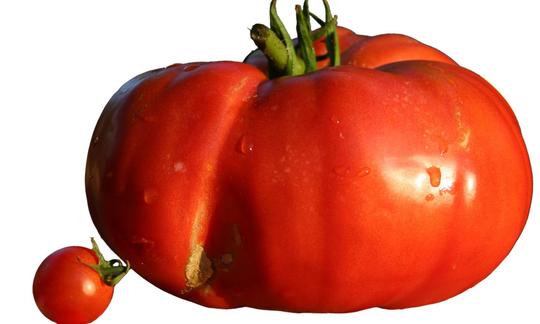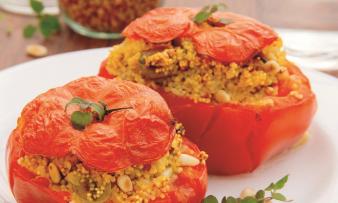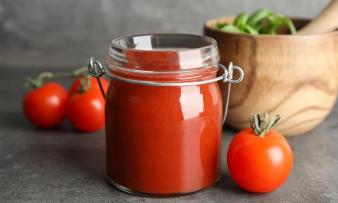Table of contents
Beefsteak tomatoes are a grouping within the tomatoes ( Solanum lycopersicum) that includes large and heavy fruits. They are often used for stuffing and gratinating, but also raw in salads (preferably in organic quality).
Use in the kitchen
There are a large number of tomato varieties. These can be divided into groups that differ in shape, size, growth type and also in use. One of these groups of tomatoes is called beefsteak tomatoes. These are particularly heavy and large specimens. Their weight ranges from 100 g to 1 kg per piece, depending on the variety. The fruits have a bag-shaped to flat-round shape and are sometimes irregularly ribbed. The colors vary from red, pink and orange to green, yellow and white to black. Another characteristic of beefsteak tomatoes is the large number of their fruit chambers (segments containing seeds). Cocktail tomatoes and cherry tomatoes have two segments and round stake tomatoes have a maximum of three. The beefsteak tomato has an average of four to six fruit chambers. 2.5
Beefsteak tomatoes have a lot of flesh and little jelly due to thick fruit walls and a relatively small number of seeds. They are a little less juicy than their smaller relatives, but no less attractive in terms of taste. In general, beefsteak tomatoes have an aromatic, sweet taste with a slight acidity. The most well-known beefsteak tomato variety is called oxheart. However, there are countless other varieties. We mention some of them further down in the "Further information" chapter.
What can you do with beefsteak tomatoes? Because of their size, beefsteak tomatoes are not ideal as a snack between meals (as is the case with cocktail tomatoes or cherry tomatoes), but they are particularly good in the kitchen. Can you eat beefsteak tomatoes raw? You can enjoy them both raw and cooked. As well as using them on the grill (halved and seasoned with oregano, garlic, salt andpepper), you can also roast them in the oven with rosemary and pine nuts. Thanks to their low juice content, they are also used in sauces and soups (hot or cold, as in the sweet and spicy pineapple and cucumber gazpacho).
In addition, their shape is ideal for filling and gratinating. You can fill the hollowed-out tomatoes with rice (or pseudo-grains, etc.), vegan minced meat or even with tofu and mushrooms. Stuffed tomatoes with millet, dried tomatoes and olives are particularly recommended.
These types of tomatoes are great as an ingredient in salads, e.g. in a Caprese salad with vegan mozzarella and fresh basil or in a Greek salad with cucumber, red bell peppers and olives. Raw beefsteak tomatoes filled with raw vegetables make an unusual starter (see "Vegan recipe for raw stuffed beefsteak tomatoes"). A tomato burger is also very tasty. Simply replace the burger buns with two halves of a large, raw beefsteak tomato.
Beefsteak tomatoes can also be used to make homemade tomato paste and vegan tartare.
Vegan recipe for raw beef tomato and melon soup
Ingredients (for 4 people): 400 g beef tomatoes (raw, organic), ½ cantaloupe melon, 1 red bell pepper, 1 tbsp lime juice, 500 ml tomato juice, a little salt andpepper, 2 spring onions, 4 sprigs of mint (e.g. peppermint or spearmint), possibly 4 tsp rapeseed oil (if required).
Preparation: For this cold soup, rinse the raw beef tomatoes, halve the cantaloupe melon, remove the seeds, peel it and cut the flesh into cubes. Set aside a few cubes for garnishing. Wash and chop the sweet peppers. Put the beef tomatoes, melon and sweet peppers in a blender. Add lime juice and tomato juice and puree everything until it has a soup-like consistency. If the cold soup is still too thick, add a little water. Season with salt and pepper and chill for about 30 minutes. Meanwhile, clean the spring onions and cut them into fine rings. Rinse the mint, shake it dry and roughly chop the leaves. Divide the raw vegan soup between four bowls. Garnish with the remaining melon cubes, spring onions and mint and drizzle with a teaspoon of rapeseed oil to taste.
Vegan recipe for raw stuffed beef tomatoes
Ingredients (for 4 people): 8 large beef tomatoes (raw, organic), 2 zucchini, 2 yellow bell peppers, 2 tbsp rapeseed oil, some salt andpepper, ½ bunch of basil.
Preparation: Wash the beef tomatoes, cut off the tops and stems and hollow out the tomatoes. Rinse the zucchini and sweet peppers, dice finely and place in a bowl. Add oil, season with salt and pepper and mix everything together well. Put the zucchini and pepper filling into the hollowed-out tomatoes. Garnish the tomatoes filled with raw vegetables with rinsed and shaken-dry basil leaves and serve. This vegan dish makes a good starter.
Vegan recipes with beefsteak tomatoes (raw) can be found under the note: " Recipes that have the most of this ingredient ".
| Not only vegans or vegetarians should read this: Vegans often eat unhealthily. Avoidable nutritional errors. |
Purchasing - Storage
The beefsteak tomato, which is one of the most commonly grown varieties in the Mediterranean region, is available in many supermarket chains such as Coop, Migros, Denner, Rewe and Edeka. Other supermarkets such as Volg, Aldi, Lidl, Spar, Hofer and Billa do not offer raw beefsteak tomatoes at all or only occasionally, e.g. during special promotions. In organic supermarkets (e.g. Denn's Biomarkt and Alnatura) you can find them in organic quality. Although tomatoes are usually available all year round, they come from the greenhouse in winter. This makes no sense either ecologically or in terms of taste - tomatoes ripened in the sun taste much more aromatic than those from the greenhouse. The tomato season in the DA-CH countries lasts from April to November. 3 You can find particularly fresh and diverse beefsteak tomatoes at weekly markets in midsummer.
The availability of beef tomatoes (raw) varies depending on the size of the store, catchment area, etc. Our recorded food prices for the DA-CH countries can be found above under the ingredient image - and by clicking you can see their development at various suppliers.
Storage tips
Beefsteak tomatoes and tomatoes in general should not be stored in the refrigerator, as the cold has a negative effect on their taste, texture and shelf life. Storage at room temperature is best for raw tomatoes. This way they will stay fresh for up to a week. Since tomatoes release the plant hormone ethene (ethylene), which causes neighboring fruits and vegetables to ripen more quickly, they should be stored separately.
Ingredients - Nutritional values - Calories
Does the beefsteak tomato contain a lot of calories? The energy content of the beefsteak tomato (raw) is 20 kcal/100g. With 0.21 g of fat per 100 g, the raw beefsteak tomato is low in fat. Carbohydrates are also sparse at 3.9 g/100g and proteins at 0.95 g/100g. Do tomatoes contain fiber? They contain 1.3 g of fiber per 100g. Raw tomatoes consist of about 94% water. 4
The raw beef tomato contains 19 mg of vitamin C per 100 g (24% of the daily requirement). This content is similar to that of zucchini (18 mg/100g) and honeydew melon (18 mg/100g). The yellow bell pepper is particularly rich in vitamin C with 184 mg/100g. 1.4
100 g of raw beefsteak tomatoes contain 33 µg of folate (17% of the daily requirement). Galia melons (30 µg/100g) and celery (36 µg/100g) contain a similar amount. With 194 µg of folate per 100 g , raw spinach provides about six times as much of this vitamin. 1,4
Beef tomatoes also contain vitamin A when raw. The content of 99 µg/100g is comparable to that of apricots (96 µg/100g) and leeks (83 µg/100g). Carrots contain particularly high levels of vitamin A (835 µg/100g). 1.4
The total nutrients of beef tomatoes (raw), the coverage of the daily requirement and comparison values with other ingredients can be found in our nutrient tables. In the article Nutrients explained you will get a detailed insight into the topic.
Health effects
The health effects of beefsteak tomatoes are mainly due to the secondary plant substances they contain.
Secondary plant substances
Our article on secondary plant substances provides an overview of the classification of substance groups, their occurrence in foods and possible effects on humans.
Beefsteak tomatoes (like other tomato varieties) contain the following secondary plant substances:
- Isoprenoids: Triterpenes: Steroids (beta-sitosterol, campesterol, stigmasterol, stigmastanol, delta-5-avenasterol, cholestanol, cholesterol, lanost-8-en-3-beta-ol, 24-oxocholesterol); Tetraterpenes: carotenoids (carotenes: lycopene, alpha-carotene, beta-carotene, gamma-carotene, neurospores, phytoene, phytofluene, zeta-carotene; xanthophylls: lutein, neoxanthin, violaxanthin, alpha-cantaxanthin, cryptoxanthin, zeaxanthin, beta-cryptoxanthin) 16,17,19,20
- Alkaloids: Glycoalkaloids (tomatin) 17,18
- Flavonoids: flavonols (rutin, quercetin, kaempferol, kaempferol-3-O-rutinoside, myricetin), flavanols (epicatechin, catechin), anthocyanins, flavones (chrysin, luteolin), flavanones (naringenin); phenolic acids: hydroxybenzoic acids (vanillic acid), hydroxycinnamic acids (chlorogenic acid, caffeic acid, p-coumaric acid, ferulic acid, sinapic acid, cinnamic acid, phloretic acid); chalcones (naringenin chalcone); stilbenes (resveratrol); tannins 16,17,18,19,20
- Nitrogen-containing compounds: Biogenic amines: Melatonin 6
However, it should be noted that the composition of secondary plant substances in beefsteak tomatoes can vary depending on the variety, time of harvest and growing conditions. Therefore, quantities are only of limited use and should only be understood roughly.
Studies show that there are significant differences between the various tomato varieties in terms of the presence and concentration of certain secondary plant substances. For example, the color of the tomatoes influences the composition of the carotenoids they contain. Darker varieties have a higher concentration of carotenoids than lighter varieties, such as yellow tomatoes. 21 Many bioactive substances are also found in greater quantities in the peel and seeds and are particularly concentrated in small cherry tomatoes. 20
Other health-promoting effects, as well as possible side effects, are the same as those of other groups of tomatoes. Read about them in the general tomato article Tomatoes, red, raw (organic?).
Ripe beefsteak tomatoes, on the other hand, contain an above-average amount of melatonin. Melatonin is a hormone produced by the body that controls the body's sleep-wake cycle. The European Food Safety Authority confirmed the ability of melatonin to eliminate jet lag, reduce sleep latency (the time it takes to fall asleep) and improve sleep quality. The sleep-promoting hormone can be found in a variety of foods, including tomatoes. Many women in postmenopause, the last phase of menopause, suffer from sleep problems. Therefore, a 2019 study examined the effect of beefsteak tomatoes on the sleep of overweight, postmenopausal women with sleep problems. The results of the study showed that administering beefsteak tomatoes over a period of eight weeks increased blood melatonin levels. Supplementing with beefsteak tomatoes before bedtime can therefore improve sleep quality in overweight, postmenopausal women. 6 The study mentioned does not say anything about the effect on other groups of people.
Ecological footprint - animal welfare
The CO 2 footprint of beef tomatoes depends on the cultivation system and regionality. Tomatoes are often grown in greenhouses, especially when the regional climate is too cold or cultivation is not possible seasonally. Heating the greenhouses allows the heat-loving plants to be grown all year round. Alternatively, foil tunnels are used or the tomatoes are grown outdoors, which drastically reduces the amount of energy required. 12 Seasonal, regional tomatoes have an average CO 2 footprint of 0.3 kg CO 2 eq/kg, regional tomatoes from the greenhouse (out of season) show a value of 2.9 kg CO 2 eq/kg. 13
Compared to small-fruited tomatoes (e.g. cocktail tomatoes or snack tomatoes), beef tomatoes have a higher yield per m 2 for the same expenditure: their ecological footprint is accordingly smaller. In addition, small tomatoes are usually sold in cardboard or plastic trays covered in foil, while larger tomatoes can also be bought loose in shops. Accordingly, they are to be preferred when shopping. 12
The amount of water required to produce 1 kg of tomatoes also depends on various factors and varies greatly in the literature. The values are between 214 and 1000 liters. 13,14 In contrast to the amount of emissions, the amount of water required for 1 kg of tomatoes from the greenhouse is on average lower than for 1 kg of tomatoes from the open field. This is a key factor, especially in dry regions. It is important to mention here that the tomatoes in such glass or plastic greenhouses grow in soilless substrates with nutrient solutions. In foil tunnels or open fields, on the other hand, the tomatoes grow in the soil and receive not only green manure but also organic-mineral fertilization. 15
For detailed explanations of various sustainability indicators (such as ecological footprint, CO2 footprint, water footprint), see our article: What does the ecological footprint mean?
Worldwide distribution - cultivation
The original distribution center of the tomato extends along the west coast of South America. The first mentions of tomatoes in Europe date from the early 16th century. The plants probably reached Europe soon after the Spanish conquest of Central America and South America. 7
Ancient Inca and Aztec civilizations were the first to domesticate tomatoes. However, tomato cultivation began in Europe. 8 The fruits of the wild tomato were small and did not serve to secure food supplies. The original aim of cultivation was to breed plants with larger fruits. 9 This probably also led to the creation of some varieties of beefsteak tomatoes.
Growing in the garden
Beefsteak tomatoes are easy to grow in your own garden. To do this, you start growing the plants in seed trays indoors from April. As soon as the first leaves have grown, you can pot the individual plants in their own pots. When the young plants are about 30 cm tall, you can transplant them into a humus-rich bed enriched with organic fertilizer. This is the case from around mid-May (but no later than nine weeks after sowing). A sunny and sheltered location is best. Since beefsteak tomato plants bear large fruits, you should tie them to sturdy rods. Otherwise the branches could break off under the heavy load. The plants need regular and copious water. Depending on the variety, tomatoes grown in your own garden are ready to harvest from the beginning of August. 2
Further information
The tomato ( Solanum lycopersicum) belongs to the nightshade family (Solanaceae). As mentioned, tomatoes are divided into groups according to fruit shape, size and growth type: e.g. stake tomatoes (with or without a tip), bush tomatoes, cherry tomatoes or beefsteak tomatoes.
Through breeding, there are around 3000 varieties of beef tomatoes. 2 In addition to the oxheart tomato, the following beef tomatoes, divided by color, are well-known and popular: 10
- Red beefsteak tomatoes: e.g. Berner Rose, Nonna Antonia, Sandul Moldovan, Brandywine (also in other colours), Bulgarian Pink Giant.
- Black (or dark) beef tomatoes: e.g. Black Pineapple Tomato, Black Prince, Carbon.
- Green beefsteak tomatoes: e.g. Green Helarios, Cherokee Green, Green Moldava.
- Yellow/white beefsteak tomatoes: e.g. Uzbekistan II, Azoychka, Great White.
Alternative names
The English name for beefsteak tomato - incorrectly also spelled meat tomato - is beefsteak tomato or beef tomato. This expression first appeared in a seed catalogue from 1869. The slices of this tomato variety were described as follows: "as firm and fleshy as a beef steak". 11
Bibliography - 20 Sources (Link to the evidence)
| 1. | USDA United States Department of Agriculture. |
| 2. | Mein-schoener-garten de: Fleischtomaten: Die besten Sorten. 2019. |
| 3. | Gemuese ch: Tomate. |
| 4. | DEBInet Deutsches Ernährungsberatungs- & -informationsnetz. Fleischtomate roh. |
| 6. | Yang TH, Chen YC, Ou TH, Chien YW. Dietary supplement of tomato can accelerate urinary aMT6s level and improve sleep quality in obese postmenopausal women. Clin Nutr. 2020;39(1):291–297. |
| 7. | Jacomet S. Die Geschichte der Tomate. Gärtnerei der LBB Lehrbetriebe. Universität Basel. 2011. |
| 8. | Bergougnoux V. The history of tomato: From domestication to biopharming. Biotechnology Advances. 2014;32(1):170–189. |
| 9. | Pflanzenforschung de Die Tomate im Wandel der Zeit. 2014. |
| 10. | Gartenjournal net: Die besten Fleischtomaten Sorten: Aromatisch und ertragreich. Jansen P. 2023. |
| 11. | LeHoullier C. Beefsteak Tomatoes: Kings of Summer Flavor. The American Gardener. July/August 2016. |
| 12. | IFEU Institu für Energie- und Umweltforschung Heidelberg. Müller-Lindenlauf M, Zipfel G, Rettenmaier N et al. CO2-Fussabdruck und weitere Umweltwirkungen von Gemüse aus Baden-Württemberg. 2013. |
| 13. | IFEU Institut für Energie- und Umweltforschung Heidelberg. Reinhardt G, Gärtner S, Wagner T. Ökologische Fussabdrücke von Lebensmitteln und Gerichten in Deutschland. Institut für Energie - und Umweltforschung Heidelberg. 2020. |
| 14. | Mekonnen MM, Hoekstra AY. The green, blue and grey water footprint of crops and derived crop products. Hydrol. Earth Syst. Sci. 2011; 15: 1577-1600. |
| 15. | Boulard T, Raeppel C, Brun R et al. Environmental impact of greenhouse tomato production in France. Agronomy for Sustainable Development 31. 2011; 757-777. |
| 16. | Perveen R, Suleria HAR, Anjum FM, Butt MS, Pasha I, Ahmad S. Tomato (Solanum lycopersicum) carotenoids and lycopenes chemistry; metabolism, absorption, nutrition, and allied health claims--a comprehensive review. Crit Rev Food Sci Nutr. 2015;55(7):919-929. |
| 17. | Ratto F, Franchini F, Musicco M, Caruso G, Di Santo SG. A narrative review on the potential of tomato and lycopene for the prevention of Alzheimer’s disease and other dementias. Critical Reviews in Food Science and Nutrition. 2022;62(18):4970–4981. |
| 18. | Chaudhary P, Sharma A, Singh B, Nagpal AK. Bioactivities of phytochemicals present in tomato. J Food Sci Technol. 2018;55(8):2833–2849. |
| 19. | Ali MY, Sina AAI, Khandker SS, Neesa L, Tanvir EM, Kabir A, et al. Nutritional composition and bioactive compounds in tomatoes and their impact on human health and disease: a review. Foods. 2020;10(1):45. |
| 20. | Bianchi AR, Vitale E, Guerretti V, Palumbo G, De Clemente IM, Vitale L, et al. Antioxidant characterization of six tomato cultivars and derived products destined for human consumption. Antioxidants. 2023;12(3):761. |
| 21. | Flores P, Sánchez E, Fenoll J, Hellín P. Genotypic variability of carotenoids in traditional tomato cultivars. Food Research International. 2017;100:510–516. |











Comments